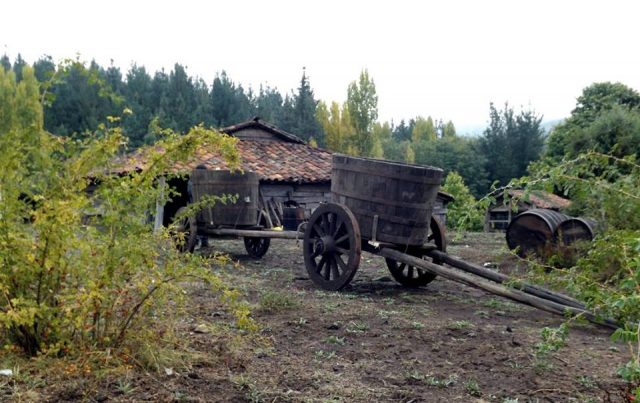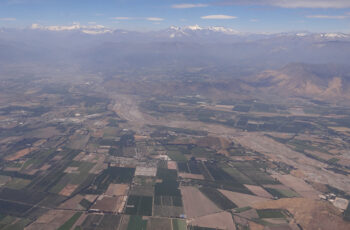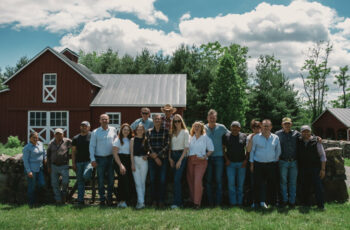
Rescuing Chilean Ancient Vineyards in 4.900 kilometers from Arica to Patagonia
With more than 18 years working across the more than 4.900 kilometers stretch from Arica-Parinacota to Patagonia, Maximiliano Morales, agricultural engineer and founder of www.andeswines.com, presented the results of his research on the rescue of old vines to an audience aboard the National Geographic Explorer Expedition Ship.

This research came as a result of a presentation he previously gave in November 2017 for students and professors at UC Davis in California. The lecture, entitled “History of ancient cultivars in Chile; Old Vine Rescue projects in 4.000 km”, discussed the introduction of vineyards into Chile during the time of the Spanish arrival, and case studies of more than five wine-producing valleys, now bottling wines with great success.
Maximiliano Morales presented his research to more than 140 passengers and staff on the NatGeo Explorer explaining the initiatives that allowed him to visit small towns with abandoned vineyards to help them reactivate their economies through the “Rescue Plan for Ancient Vineyards”. This plan was put into operation in the San Rosendo at the intersection of the Laja and Bio Bio rivers, Portezuelo in the Itata Valley, Cauquenes in the Maule Valley, and in the Puelo Valley, Los Lagos.
As an agricultural engineer, Morales used the wine innovation methodology developed during his time at the University of San Francisco to organize seminars, talks, and visits from specialists who could teach wine producers in rural areas near the Laja river in San Rosendo to prune their vines and matched them with well-recognized wine experts who fermented the grapes that were going to be lost.
The forestry business of pines and eucalyptus plantations is gradually using more of the available land. Consequently, local grape producers are becoming increasingly conscious about the need to save the remaining vines as a matter of DNA treasure with great potential for producing unique wines.
These efforts have featured in more than 100 articles in international publications

In the case of the San Rosendo Malbec, Maximiliano was able to assemble wine bottlers who provided bottles and wine label designs to improve the wine’s brand. This process continues with the support of the Wine Acceleration Program of AndesWines, which will manage the territory alongside Manuel Escobar, a wine producer in the small railroad town with French heritage.
For Morales, this process began when he began work as a tour guide specializing in wines and pisco, structuring tours and explorations of wine-producing areas in the Elqui Valley and Limarí from 2001. He also started to serve luxury cruise ships, and has been a Freelance Wine Specialist on international ships such as the National Geographic Explorer Expedition Ship since 2006.
Presenting unpublished data from the investigation, Maximiliano Morales explained how the search process in the Puelo Valley, inside the Tagua Tagua Park, led them to a vine that had climbed over eight metres into an oak tree.

The Swiss geneticist, José Vouillamoz, visited the area last year alongside wine reporter and expert, Jancis Robinson, and conducted a DNA profiling of the vine. He concluded that it was of the Bonarda variety.
In 2015 CORFO, the Chilean government’s Innovation Agency, hired Morales as their strategic wine consultant. As part of this he went on to lead the “Nodo Estratégico Chile Vitivinícola 2.0” project. Morales’ particular challenge was the creation of the Chilean wine route as part of a strategy to conserve ancient vineyards in the face of increasing climate change and frontier extension.
Morales led the process of extending the borders of Chile’s wine-producing regions to the North and South, as well as further toward the coast and the Andes foothills, with a particular focus on creating new products based on previously forgotten vines.
This process sought to bring value to traditional wine production techniques that date back when the first vineyards were established on the coast of the Bio Bio Region in 1551 and in La Serena while the city was being founded few years later. All researched by the historian, Fernando Arriagada who collaborated with Morales.
New but old ancient vineyard discovered in Chile
Since the arrival of the Spanish in South America, Cusco had been receiving most of the grapes coming from the Canary Islands. However, Chile also received several ships coming south, crossing the Strait of Magellan from Italy and France as well as Spain itself.
These ships sailed across the Atlantic, entered the Strait of Magellan and then arrived into Concepcion Bay in the 1600-1800s. They brought Italians, French and Spanish carrying various grapevines to be established in the new continent, arriving mainly to the “Bay of Concepcion”, now Talcahuano Port.
Chile is leading a combined public/private strategy to search for old vines along the 5.000 kilometres from Arica to Punta Arenas; that latter a place where a surviving old vine can be found inside the Braun Family crystal house in the main square in the middle of the city
From the Arica-Parinacota Region in the north at the border with Peru to Chile Chico, the focus has been on creating new economic activity based on wine production for small localities with almost abandoned vineyards, under a Plan de Rescate de Viñedos Antiguos [Rescue old Vine Projects] by AndesWines.
Codpa Valley, Arica-Parinacota Region
There has been constant, and currently ongoing, work carried out in the northern area over 1200 kilometers south of Lima, Perú in the Codpa Valley, through grafts of varieties such as Malbec and Syrah over “pais vines” and the maintenance of the local adapted varieties brought by Spanish.

However, there are other vineyards that have fallen out of the scope of this work, that are isolated and even abandoned at “parronales” which have no commercial destination due to the loss of competitiveness and lack of awareness of the real potential that this genetic material possesses.
Pintatani is the name of the grape and wine bottled and produced by local farmers who sell most of their small production to cruise ship tourist and Chilean visitors. Most of the locals sell to tourists have no interest on improving the quality and winemaking techniques due to the high price people already pay; up to $15 USD per bottle. Further they want to maintain their traditional methods of producing, bottle and corking by hand; an experience that visitors can join in with personally.
Toconao in San Pedro de Atacama, Antofagasta Region
There has been constant work in the Toconao area in San Pedro de Atacama, through grafts of varieties such as Malbec and Syrah. Still though, there are other vineyards that have not been included and are isolated and even abandoned with no commercial direction due to the loss of competitiveness and lack of awareness of the real potential that this genetic material possesses.

Toconao is an unknown area for most wine critics. Few know of the existence of several “oases” with underground water and human settlements and agriculture developments.
Grapes brought by Spanish are part of the success and new releases from wineries such as Tara of Ventisquero or “Ayllu” A collaborative wine project lead by Roberto Carrancá formerly of the Indomita Winery is bringing change and opening new opportunities for local producers thanks to big wineries that buy the grapes and produce the wine in the area.
Among independent producers under the collaborative brand Ayllu, there have been commercialization issues due to the widespread variety of wine types produced under the same brand, changing only the name of the producer on the label.
It is worth noting though, that most wines are bottled at 750cc, and has suggested by AndesWines as part of a Corporate Social Responsibility project, a format of 375cc or 500cc would the facilitate the sale of the wines in the restaurants and boutique hotels of the area. The high price, larger size format has given difficulties in the sale of wines.
Elqui and Limari Valley at Coquimbo Region
Aside from the pisco niche (distillation of wines from grapes such as Muscatel de Alejandria, “pastilla”, Torontel, amongst others) there are other unknown grapes such as “ovoide” that INIA has been working on to produce a sparkling wine.

Other unknown grapes are located at the base of the valleys, adjacent to the rivers including the Elqui, Limari and Choapa in the Coquimbo Region, are isolated and even abandoned as they have no commercial strategy, little competitiveness and ignorance of the value potential of this genetic material. This includes vineyards that are the product of the originals established with the arrival of the Spanish from Cusco until they reached La Serena in Coquimbo Region. These grapevines are in the homes of local inhabitants, and are used as “parronales” to weather the hot climate of the valleys, but they represent an unexplored genetic treasure.
Valle del Maule
In regard to Valle del Maule, the importance of rescuing vineyards located in the Cauquenes Valley and specific sectors of Name, Caliboro, Coronel de Maule, as well as all the vineyards in the vicinity of Talca and Curicó was prioritized.
The leading winery rescuing old winemaking techniques and lost grape vines in this valley is Count Francesco Marone Cinzano, owner of Coldorcia in Tuscany that in the last 25 years has been working with Erasmo Organic Winery in Caliboro area in Maule Valley.
Curico Valley in Maule Valley
Former oenological Director of Moët et Chandon George Blanck has been working in Chile for a few years, and in recent months he visited to present his latest creation- Gran Brut Sparkling 2015- his collaboration with the winemaking team of Folatre Family Wines led by José Luis Martin Bouquillard, General Manager of the Winery.

After many years preparing the grapes thanks to vineyard management and winemaking technics, they were confident to launch the sparkling wine with the consulting of George Blanck who approved the Gran Brut Sparkling 2015 as ready.
Considering Blanck is well respected in Champagne, this adventure to produce his first Sparkling in Chile begins a great challenge; to keep looking for the best grapes of the Curico Valley in the South of Chile to surprise the local and international markets.
Araucania Region
Regarding the case of Araucanía, it is emphasized that for many years the habitants and authorities knew of the existence of these old vineyards, spread throughout the region, but had not given them importance until 2015, when CORFO, the innovation agency of Chilean government created the program “Nodo Estratégico Chile Vitivinícola 2.0” through to mid 2016.

The goal of that program was to structure of the road map of Chilean wine industry for the next 30 years, based on the discovery of old vines spread out in the country from Maule to Aysén Region generating, among other things, a strategy around the ancient vineyards confronting the challenges brought by Climate Change.
Bearing in mind that the area was influenced by Italians arriving there, the town of Capitan Pastene has several unknown grapes not yet identified, plus new vineyards established over the last couple of years in the Cautín and Malleco Valleys. Right now, Araucania Region has almost 120 hectares from 12 wineries / brands, bottling wines in seven locations; Traiguén, Victoria, Curacautín, Lumaco, Los Sauces, Villarrica and Perquenco.
Despite the new varieties planted; Chardonnay, Pinot Noir, Sauvignon Blanc, Syrah and Sangiovese, the locals are finally taking seriously the “Moscatel” in the Angol town, very close to southern Bio Bio Region and Capitan Pastene surrounding area.
Several winemakers are finding other varieties brought by immigrants from 1904-1905 when 88 families arrived to the area from Italian towns of Guiglia, Pavullo and Zocca, Módena.
South of Bio-Bio Region
Nacimiento is a town at the south limit of Bio Bio Region (river). Located north of Araucania Region. Millapoa, San José and San Ramón are small locations where grapes were brought by Jesuits over 200 years ago. “Pais” is the local grape that is mixed up with few other vines in the near 70 hectares that still produce “chicha” and everyday wine that is consumed locally, with some sent to Concepcion and Los Angeles to be consumed during the festivities of National Independence Day.
Puelo Valley and Cochamo at Los Lagos Region
Among the unpublished facts of the DNA Profiling made by Swiss geneticist José Vouillamoz on the Bonarda Vine found inside the private Park Tagua Tagua a few years ago, is that several unknown vines were researched by AndesWines. Several Argentinean families and Chilean moving along the “Paso el León” frontier border brought grapes and established a “parronal” in their backyard.
All of those grapes and others not yet identified, together with the projections of this research and its findings are driving the challenge to produce wines from these grapes for touristic purposes.
Currently, through the AndesWines Innovation Division and the work of Maximiliano Morales, the search continues for lost vines in several wine valleys to carry out vineyard rescue projects, as well as exporting this methodology to other countries in the coming months, in partnership with local winemakers to strengthen the economic reactivation of vineyards that are practically abandoned without a commercial use.
Grapes are good. Wine is even better!!!














